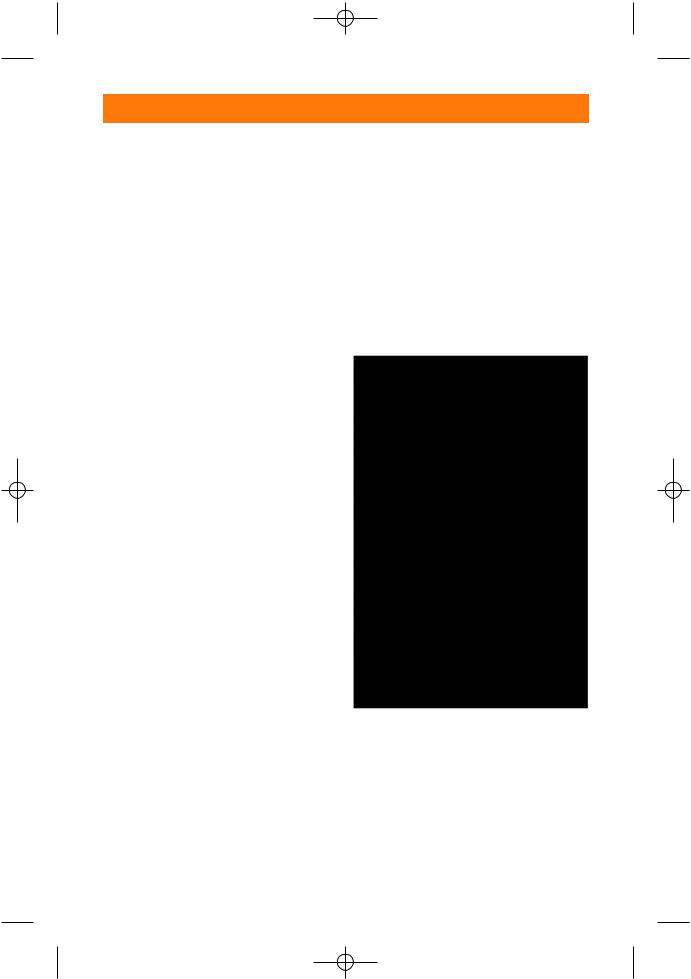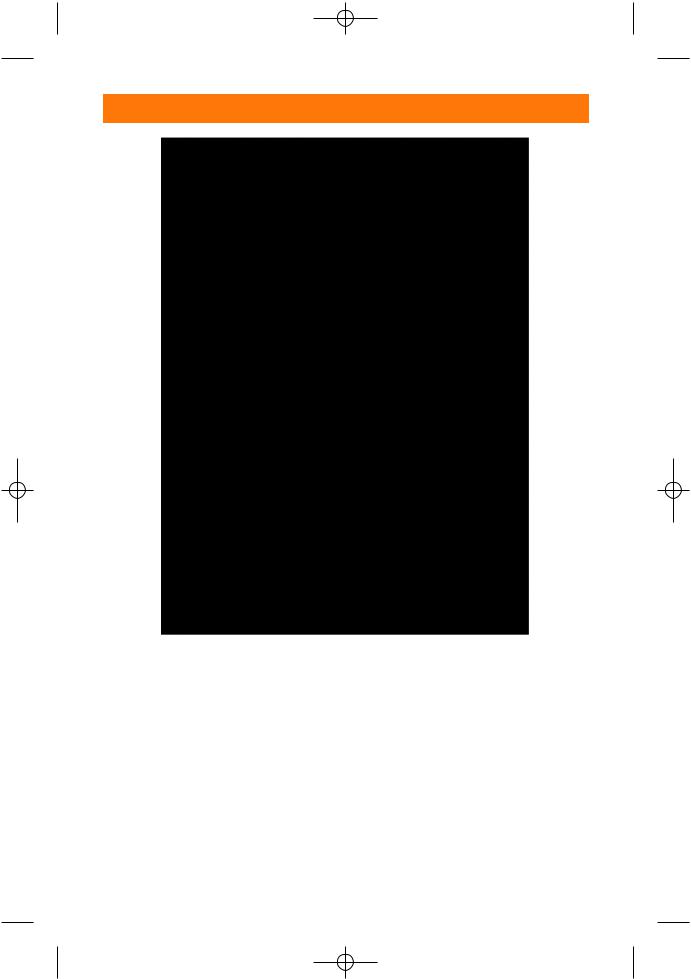
0470045272
.pdf
12_045275 ch06.qxp 11/28/06 8:26 PM Page 151
Chapter 6 Real World Applications 151
Outdoor portrait photography practice
6.31 Ashley, Lake Travis, Austin, TX / Nikon D70 with Tamron 70-300mm f/4-5.6 at 110mm. ISO 200, 1/160 sec. at f/5.6 with the SB-600 set to TTL BL.

12_045275 ch06.qxp 11/28/06 8:26 PM Page 152
152 Part II Creating Great Photos with the Creative Lighting System
|
Table 6.10 |
|
Taking Outdoor Portrait Pictures |
|
|
Setup |
Practice Picture: Figure 6.31 was taken during a trip to the lake. |
|
The sun was going down, creating a beautiful color of light. |
|
On Your Own: When the sun is setting, the sky reflects the warm |
|
color on to your subject. This time is often the best to take |
|
portraits outdoors. |
|
|
Lighting |
Practice Picture: I used the built-in Speedlight to add some fill — |
|
because the sun was almost behind my model, she was a little |
|
backlit. |
|
On Your Own: Use the fill flash setting whenever your subject is |
|
backlit or if the angle of the sun is creating harsh shadows. |
|
|
Lens |
Practice Picture: Tamron 70-300mm f/4-5.6 set at 110mm |
|
On Your Own: Use a long telephoto lens to flatten your models |
|
features. The further you are away from the model the less the |
|
apparent distance from their features is. Apparent distance is the |
|
distance objects look from each other from a certain perspective. |
|
Using a wide-angle lens at close range can cause the nose to |
|
look big while also causing the ears to look too small. |
|
|
Camera Settings |
Practice Picture: Aperture Priority setting, matrix metering. I |
|
chose the AP setting in order to choose a wide aperture to throw |
|
the background out of focus. The light meter was set to matrix in |
|
order to use the Speedlight in the TTL BL mode. |
|
On Your Own: Use Aperture Priority to be able to set your |
|
aperture to control your depth of field. |
|
|
Exposure |
Practice Picture: 1/160 sec. at f/5.6, ISO 200 |
|
On Your Own: Be sure you set your aperture so that you subject’s |
|
entire face is in focus, but the background is out of focus so that |
|
the background isn’t competing with your model for attention. |
|
|
Accessories |
A reflector of some sort can be used to fill in any deep shadows |
|
on your subject. |
|
|
Outdoor portrait photography tips
Shoot early in the morning or late in the afternoon. The sunlight when the sun is rising or setting can give your subjects a pleasing warm tone. When the sun is high in the sky during the mid-afternoon hours, the light is often harsh and can cause severe shadows.
Use a wide aperture. Using a wide aperture creates a pleasing out of focus background. This effect is known as bokeh, pronounced bo-keh. This comes from the Japanese word “boke” which means fuzziness or dizziness.

12_045275 ch06.qxp 11/28/06 8:26 PM Page 153
Chapter 6 Real World Applications 153
Still Life and
Product
Photography
In still life and product photography, lighting is the key to making the image work. You can set a tone using creative lighting to convey the feeling of the subject. You can also use lighting to show texture, color, and form to turn a dull image into a great one.
When practicing for product shots or experimenting with a still life, the first task you need to undertake is to find something to photograph. It can be one object or a collection of objects. Remember if you are shooting a collection of objects, try to keep within a particular theme so the image has a feeling of continuity. Start by deciding which object you want to have as the main subject then place the other objects around it, paying close attention to the balance of the composition.
The background is another important consideration when photographing products or still life scenes. Having an uncluttered background in order to showcase your subject is often best, although you may want to show the particular item in a scene. An example of this would be possibly photographing a piece of fruit on a cutting board with a knife in a kitchen.
Diffused lighting is essential in this type of photography. You don’t want harsh shadows making your image look like it was shot with a flash. The idea is to light it so it doesn’t look as if it was lit. You want to use an umbrella or softbox to soften the shadows. If none of these are available, bouncing the flash off of the ceiling or a nearby wall can do the trick.
Even with diffusion, the shadow areas need some filling in. You can do this by using a second Speedlight as fill or by using a fill card. A fill card is a piece of white foam board or poster board used to bounce some light from the main light back into the shadows lightening them a bit. When using two or more Speedlights, be sure that your fill light isn’t too bright, or it can cause you to have two shadows. Remember, the key to good lighting is to emulate the natural lighting of the sun.
6.32 Vintage bottle / Nikon D70 with Tamron 70-300 f/4-5.6 at 100mm. ISO 200, 1/30 sec. at f/8 with two SB-600’s lighting the bottle and one SB-800 lighting the background. All Speedlights set to Manual mode.

12_045275 ch06.qxp 11/28/06 8:26 PM Page 154
154 Part II Creating Great Photos with the Creative Lighting System
Inspiration
When searching for subjects for a still life shot, try using some personal items. Objects such as jewelry or watches, a collection of trinkets you bought on vacation, or even
seashells you brought home from the beach. If you’re interested in cooking try photographing some dishes you prepared. Fruits and vegetables are always good subjects, especially when they have vivid colors or interesting texture.
6.33 Longhorn cheese with bread and crackers / Nikon D70 with Tamron 70-300 f/4-5.6 at 200mm. ISO 200, 1/60 sec. at f/5.6 with two SB-800’s set to Manual mode fired via PC sync cord.

12_045275 ch06.qxp 11/28/06 8:26 PM Page 155
Chapter 6 Real World Applications 155
Still life and product photography practice
6.34 Favorite shoes / Nikon D70 with Nikkor 18-70 f/3.5-4.5 at 30mm. ISO 200, 1/500 sec. at f/11 with one SB-800 and one SB-600 both set to TTL.
|
Table 6.11 |
|
Taking Still Life and Product Pictures |
|
|
Setup |
Practice Picture: For figure 6.34, I set up an old pair of favorite |
|
shoes on grey seamless paper. |
|
On Your Own: Keep your set simple, but still try to evoke a |
|
mood. Try to use a background that’s complimentary for the color |
|
of the subject or subjects you are photographing. |
|
Continued |

12_045275 ch06.qxp 11/28/06 8:26 PM Page 156
156 Part II Creating Great Photos with the Creative Lighting System
|
Table 6.11 (continued) |
|
|
Lighting |
Practice Picture: For this shot I used one SB-600 Speedlight and |
|
one SB-800. For the main light I had the SB-800 in a soft box |
|
positioned up high. For the fill I placed a second Speedlight in a |
|
soft box fairly close up on the right side. I placed the fill light |
|
close in order to use the Speedlight to fill in the dark shadows |
|
created by the main light. |
|
On Your Own: Make sure your light is well diffused to soften the |
|
shadows. Take a lot of test shots to see how the light is showing |
|
off the texture of your subject. |
|
|
Lens |
Practice Picture: Nikkor 18-70mm f/3.5-4.5 set to 30mm |
|
On Your Own: Use a fairly wide angle lens. Using a wide-angle |
|
lens enables you to add an interesting perspective to the subject. |
Camera Settings |
Practice Picture: Manual mode |
|
On Your Own: Manual mode or Aperture Priority mode to be |
|
able to control the depth of field. |
|
|
Exposure |
Practice Picture: 1/500 sec. at f/11, ISO 200 |
|
On Your Own: Because your subject is stationary, the shutter |
|
speed isn’t as much of an issue. Be sure you set your aperture so |
|
you can carry enough depth of field to ensure that everything is in |
|
focus from front to back. |
|
|
Accessories |
Use soft box to diffuse the light from the Speedlights. |
|
|
Still life and product photography tips
Keep it simple. Don’t try to pack too many objects in your composition. Having too many objects for the eye to focus on can lead to a confusing image.
Use items with bold colors and dynamic shapes. Bright colors and shapes can be eye-catching and add interest to your composition.
Vary your light output. When using more than one light on the subject, use one as a fill light setting it to fire at a lower power in order to add a little depth to subject by creating subtle shadows.

12_045275 ch06.qxp 11/28/06 8:26 PM Page 157
Chapter 6 Real World Applications 157
Studio Portrait
Photography
Shooting portraits in the studio involves more set up than other types of portrait photography. Whether your studio is in a set location or it’s portable, the setup usually includes a background with stands, at least two lights with stands, umbrellas or softboxes, reflectors, and so forth.
Studio portraits are usually more formal than outdoor portraits, which tend to have a more relaxed feeling to them. Two major elements to remember when shooting a portrait in a studio are:
Control the background. Being able to control your background keeps distracting elements out of your image and focuses the attention where it should be, on your subject.
Control the lighting. Unlike when you’re shooting outdoors, in the studio you choose where the light falls on your subject, how much light is falling on your subject, and how the shadows look, by using modifiers, such as umbrellas and softboxes.
Although, studio portraits are more formal than outdoor portraits, don’t be afraid to encourage your model to have fun with the shoot. You can try to make him or her laugh or suggest a few wacky poses. Also, remember that “formal” doesn’t necessarily mean boring or serious. However, depending on your subject, you may find you like the more traditional, serious look.
As you do more and more portraits, you will find yourself developing a style. Almost all famous portrait photographers have their own personal style that reflects their own personality while also capturing the essence of the model.

12_045275 ch06.qxp 11/28/06 8:26 PM Page 158
158 Part II Creating Great Photos with the Creative Lighting System
6.35 Sara / Nikon D200 with Nikkor 80-200mm f/2.8 at 86mm. ISO 100, 1/250 sec. at f/4 with the SB-800 Set to TTL exposure compensation +1 bounced from an umbrella.
Inspiration
When photographing studio portraits, I often have subjects go for a more glamorous look. It’s a great feeling when subjects look at a portrait you took and they are completely impressed by how beautiful or handsome they look.
Outside of practicing on family and friends, to find models for these types of shots, a great place to start is at beauty salons. Hairstylists often need pictures for their portfolios and in exchange for the photography, will often find the models and do the hair and makeup for you.

12_045275 ch06.qxp 11/28/06 8:26 PM Page 159
Chapter 6 Real World Applications 159
Another good source of models are actors and models who are just starting out in the business. They are often willing to trade time for prints, better known as TFP or since
the advent of digital, TFCD. It’s a good way to get your portfolio built up without having to pay for models.
6.36 Salon Square, Las Vegas, NV / Nikon D70 with Nikkor 80-200mm f/2.8 at 80mm. ISO 200, 1/500 sec. at f/4.5 with the SB-600 set to TTL shot through an umbrella.

12_045275 ch06.qxp 11/28/06 8:26 PM Page 160
160 Part II Creating Great Photos with the Creative Lighting System
Studio portrait photography practice
6.37 Montage Salon, Las Vegas, NV / Nikon D70 with Nikkor 80-200mm f/2.8 at 80mm. ISO 200, 1/500 sec. at f/5.6, with two SB-600’s controlled via D70 built-in Speedlight.
